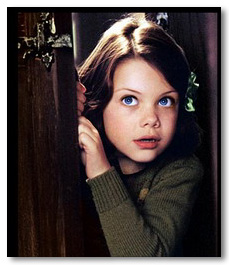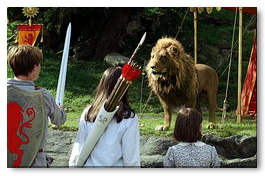The Chronicles of Narnia: The Lion, the Witch, and the Wardrobe
- FREDERICA MATHEWES-GREEN
Thanks no doubt to the guiding hand of Lewis' stepson, Douglas Gresham (himself a well-known evangelical), the script keeps the faith. Yet the message does not overpower the story (despite Tolkien's fears), but rather hits the very target Lewis intended.
 |
Lucy
Pevensie (Georgie Henley) |
Any director who attempts to bring a beloved novel to the screen can expect his fair share of slings and arrows. Just ask Peter Jackson, the hardworking genius behind the Lord of the Rings trilogy, or any of the parade of directors who have delivered Harry Potter films. The latest to step up for a smackdown is Andrew Adamson, previously known for Shrek, as he offers his fresh and magnificent production of C.S. Lewis' novel, The Chronicles of Narnia: The Lion, the Witch, and the Wardrobe.
Unlike the Potter directors, Adamson has not only junior readers to please, but armies of adults who have treasured every page in this seven-book series over the fifty-plus years since it was published. (That accounts for the bulky title: the whole set is The Chronicles of Narnia, and the Wardrobe volume, published first, makes an excellent introduction.) And, unlike Jackson, Adamson has to deal with fairly explicit religious content. J.R.R. Tolkien, author of Lord of the Rings, and Lewis were fellow professors at Oxford; they were close friends, and Tolkien facilitated Lewis' conversion to Christian faith. Both men hoped to use fiction to convey profound truths, and they met regularly to share works in progress. But Tolkien felt that Lewis went too far in Narnia, and warned his friend that the allegory was laid on too thick. Evangelical Christians prize this book because it presents the Gospel squarely, and any attempt to soften those elements would bring out the gangs carrying pitchforks and torches.
Never fear. Thanks no doubt to the guiding hand of Lewis' stepson, Douglas Gresham (himself a well-known evangelical), the script keeps the faith. Yet the message does not overpower the story (despite Tolkien's fears), but rather hits the very target Lewis intended. It draws its emotional power from the spot inside that lifts up when we catch the refrain of that "old, old story," in which a supernatural battle is won by glorious self-sacrifice. This is a story, Lewis would say, that God has prepared human beings to recognize when we hear it, and hid inside our hearts from our creation.
Everything that is strong and good and satisfying in this movie can be found in the book. The main characters are brilliantly realized, and skirt potential problems by wise casting. The littlest of the four children, Lucy Pevensie (Georgie Henley) is indisputably a child, with a broad face made squarer by a side part, wearing a Peter Pan collar and with a bow pinned in her hair. This is a refreshing change after excessively pretty leads in movies like A Series of Unfortunate Events and Because of Winn Dixie, young actresses who look more like Junior Miss contestants than real little girls.
Lucy's sister Susan (Anna Popplewell) and brother Edmund (Skandar Keynes) are likewise believably real, and only big brother Peter (William Moseley) appears to have been plucked from a teenaged Brad Pitt lookalike file. Unfortunately, Peter also has the most unrelievedly noble role of the four children, and such a character threatens to turn bland even with much more experienced actors.
 |
Tilda Swinton is extraordinary as the White Witch. When I made a recording of this book for my grandchildren, I gave the Witch the full Cruella DeVille treatment, going from oily to raging to haughty to manic in a single paragraph. Well, that's one approach, and at least one young recipient preferred to listen to the recording with the lights on. But Swinton does something much more intelligent with the role. Even when most exhilarated, at the height of her powers, she is still apprehensive; she breathes with her mouth open, like an animal. She's pale, hungry and tense. It's an original approach, and juices up the movie.
Aslan caps all, however. I expected to be disappointed it would seem that any visible depiction of this majestic character would inevitably reduce it. But this Aslan succeeds, and I think one secret is that the character's eyes are somewhat hard to read. They're the same color as his tawny mane, and sometimes hidden by it. This inscrutability preserves mystery in a character who, if he was fully comprehensible, would be too small.
![]()
But if the film just misses perfection, it's because elements that don't appear in the book have been imported to fit contemporary moviegoers' expectations. For example, though the book's battle scene takes just three swift, clean pages, in the film it is a grand set-piece, piled with all the CGI extravagance we now take for granted. There's an invented sequence in which the children must cross a frozen river as it thaws, and ride an ice floe down the flood, but it feels contrived, not to mention pointless. Not for a moment do we believe that any of these characters are in serious danger. Tension is cranked up and cranked down again, just because that's the way the formula goes.
| The best parts of this film are those that are urgent and authentic the tense and glittering Witch, the dear, believable child Lucy, the piercing moment of Aslan's death. The parts that limp are those that were invented to fulfill the dreary rules about what a contemporary family blockbuster must include. |
Moviegoers expect tension in the dialogue, too. In the book, the children are touchingly polite and sensitive to others' feelings. In an early passage, when a guilt-stricken Faun tries to tell Lucy that he is a wicked kidnapper, she persists in consoling and reassuring him, not realizing that she is his victim. Yet children aren't touchingly polite any more, so these characters must bicker at each other ("This is not our war!" "Mom isn't here!"). I guess they don't apologize either; the exchange toward the end, when Edmund asks his siblings' forgiveness, is quietly dropped.
And it shouldn't be surprising, I guess, that logic has fallen out of fashion. In the book, Peter and Susan come to the Professor concerned about Lucy's tales. He exclaims, "Why don't they teach logic at these schools!" Either Lucy is telling lies, he explains, or is mad, or is telling the truth; since she is obviously neither mad nor a liar, Narnia may well be real. But in the film this is reversed; it's Susan who tells the Professor that "Logically, it's impossible," and the Professor's comeback, "What do they teach in schools these days?" indicates exasperation with mere logic.
Not every new element is unwelcome, however. Book fans will be surprised by the opening, which shows London during a wartime bombing raid. We see the children and their mother huddling for shelter as a formation of jets, regular as a wallpaper pattern, cover the night sky. This supplies the backstory that Lewis' original readers would have known too well, and explains why the children are sent to the Professor's countryside estate. In the shelter, Edmund grips a framed photo of his soldier dad, though the glass is smashed. Later, the Faun Tumnus looks at his own father's portrait, and mourns that he is not as good a Faun as his dad; on a next visit to Tumnus' cave, the portrait is smashed on the floor. And, when the great battle begins, the flying griffins that hurl rocks on the enemy cover the sky in familiar formation. Visual echoes like these work well in a movie, but would seem forced in print.
The best parts of this film are those that are urgent and authentic the tense and glittering Witch, the dear, believable child Lucy, the piercing moment of Aslan's death. The parts that limp are those that were invented to fulfill the dreary rules about what a contemporary family blockbuster must include. Those are the moments that, a few decades from now, will seem dated and out of tune with the harmonious original. But that's all right, because in the future there will still be fast-forward buttons on home video systems, when your great-great grandchildren watch and re-watch this marvelous story as they surely will.
![]()
 This is Meaghen Gonzalez, Editor of CERC. I hope you appreciated this piece. We curate these articles especially for believers like you.
This is Meaghen Gonzalez, Editor of CERC. I hope you appreciated this piece. We curate these articles especially for believers like you.
Please show your appreciation by making a $3 donation. CERC is entirely reader supported.

Acknowledgement
Frederica Mathewes-Green. "The Chronicles of Narnia: The Lion, the Witch, and the Wardrobe." National Review (December 9, 2005).
This article is reprinted with permission from National Review. To subscribe to the National Review write P.O. Box 668, Mount Morris, Ill 61054-0668 or phone 815-734-1232.
The Author
Frederica Mathewes-Green is a wide-ranging author. She has published 9 books, including Facing East: A Pilgrim's Journey into the Mysteries of Orthodoxy, The Illumined Heart: The Ancient Christian Path of Transformation, At the Corner of East and Now, The Illumined Heart, The Open Door: Entering the Sanctuary of Icons and Prayer, and Gender: Men, Women, Sex, and Feminism. In the past, her commentaries have been heard on National Public Radio's All Things Considered and Morning Edition. Her essays were selected for Best Christian Writing in 2000, 2002, 2004, and 2006, and Best Spiritual Writing in 1998 and 2007. She has published over 700 articles. She lives in Linthicum, Maryland, with her husband Fr. Gregory, pastor of Holy Cross Orthodox Church. They have three children and three grandchildren.
Copyright © 2005 National Review



